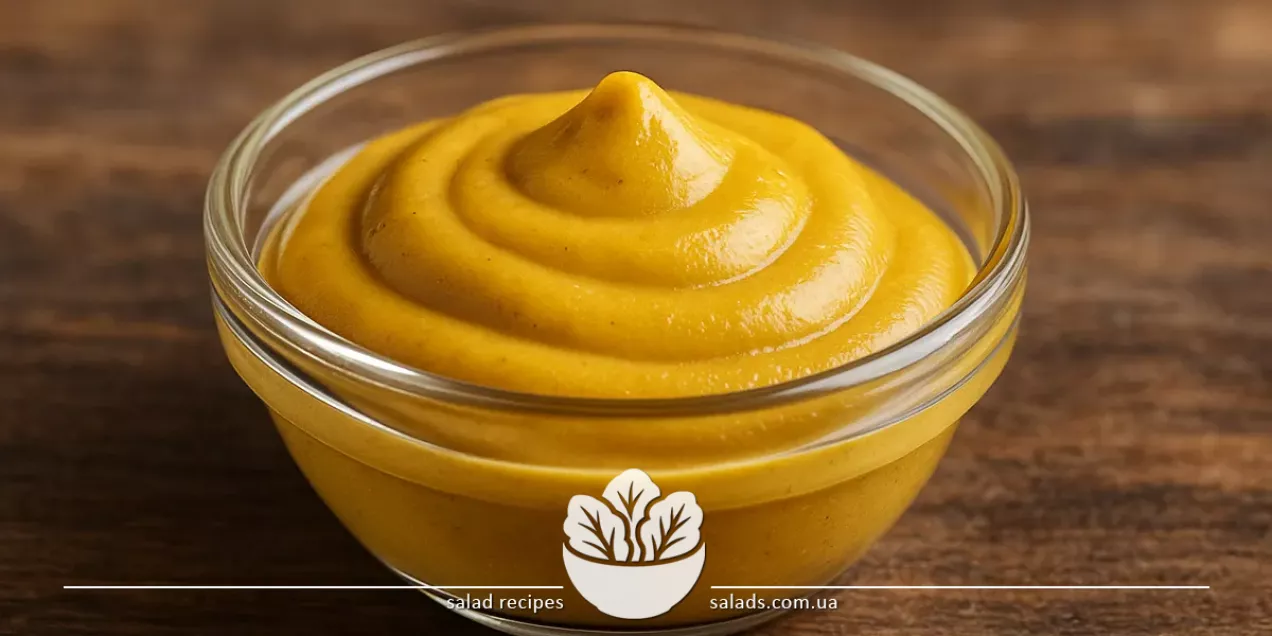
Mustard

Mustard is a prepared condiment in the form of a paste or liquid sauce made from ground mustard seeds, vinegar, water, salt, and spices. It has a pungent, distinctive taste and aroma, widely used to add zest to meat, fish, and vegetable dishes, as well as to dressings and marinades. Ready-made mustard is convenient to use and is often an essential component of cold appetizers, sandwiches, and salads. Learn more about mustard in the types of mustard section.
Salad Recipes with Mustard
Classic Mustard Recipes
As a prepared condiment, mustard is often used in cooking to create bold and tangy flavors. It is a key ingredient in many traditional recipes, especially when paired with meats such as smoked pork belly or ham, enhancing their spiciness and richness. Thanks to its strong aroma, mustard emphasizes the natural flavor of meat and provides a harmonious taste balance. In preparing cold appetizers and salads, mustard pairs well with herring, lemons, and vegetables such as carrots, giving dishes a characteristic tang and freshness. It is used as a dressing and a marinade ingredient, enriching the overall flavor and aroma. Besides classic dishes, mustard is also used in original sauces and dressings, combined with other spices and ingredients to create unique culinary compositions. Its sharp and bold taste makes mustard a versatile ingredient in many cuisines around the world.
Mustard in Global Culinary Traditions
Prepared mustard is widely used in various cuisines around the world, particularly in European, American, and Asian cooking. In French cuisine, mustard is the base for many sauces and dressings – Dijon mustard, for example, is known for its refined flavor and is used in marinades and side dishes. In American cuisine, mustard is commonly added to sandwiches, grilled dishes, and barbecue sauces, where it provides tang and spice. In German cuisine, mustard is served with sausages and ham, enhancing their flavor. In Asian culinary traditions, mustard is included in spicy pastes and sauces that bring intense aroma and heat to dishes. The versatility of mustard allows it to complement a wide range of culinary styles and create striking flavor accents.
Choosing and Evaluating Mustard Quality
When selecting prepared mustard, it is important to pay attention to its ingredients and texture. High-quality mustard contains natural mustard seeds, vinegar or lemon juice, salt, water, and minimal preservatives or artificial flavors. It can be either smooth or grainy, with varying levels of heat. The product’s color and aroma are also important: natural mustard has a rich yellow or brown hue and a distinct, spicy scent. Products with overly bright coloring or artificial additives should be avoided. Shelf life and storage conditions also play a key role in preserving flavor. A quality product retains its aroma and heat longer, allowing for more effective culinary use.
Making and Using Mustard
Prepared mustard is made by grinding mustard seeds, mixing them with liquids – vinegar, water, or wine – and adding salt, spices, and, if needed, sweeteners. The proportions of these ingredients determine the condiment’s heat, consistency, and flavor. Mustard is widely used as a condiment for meats, fish, vegetables, cheeses, and sandwiches. It serves as a base for sauces, marinades, and dressings, adding depth and intensity. It is often combined with honey, garlic, herbs, and various spices to create unique flavor blends. Thanks to its boldness and versatility, prepared mustard makes dishes more flavorful, aromatic, and appealing, and is widely used in culinary traditions around the world. It is one of the most popular condiments globally.
Storing Mustard and Using Leftovers
Prepared mustard in the form of a paste or sauce should be refrigerated after opening in a tightly sealed container to preserve its aroma and heat. When stored properly, it maintains its qualities for several weeks to several months. It is not recommended to store opened mustard at room temperature, as this may lead to quality degradation and mold. For long-term storage, use small portions or purchase mustard in sealed packaging. Leftover mustard can be used in new sauces, marinades, or added to both hot and cold dishes, helping to avoid food waste and retain the condiment’s bold flavor. Proper storage extends the product’s shelf life without sacrificing quality.